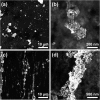Arrangement at the nanoscale: Effect on magnetic particle hyperthermia
- PMID: 27897195
- PMCID: PMC5126575
- DOI: 10.1038/srep37934
Arrangement at the nanoscale: Effect on magnetic particle hyperthermia
Abstract
In this work, we present the arrangement of Fe3O4 magnetic nanoparticles into 3D linear chains and its effect on magnetic particle hyperthermia efficiency. The alignment has been performed under a 40 mT magnetic field in an agarose gel matrix. Two different sizes of magnetite nanoparticles, 10 and 40 nm, have been examined, exhibiting room temperature superparamagnetic and ferromagnetic behavior, in terms of DC magnetic field, respectively. The chain formation is experimentally visualized by scanning electron microscopy images. A molecular Dynamics anisotropic diffusion model that outlines the role of intrinsic particle properties and inter-particle distances on dipolar interactions has been used to simulate the chain formation process. The anisotropic character of the aligned samples is also reflected to ferromagnetic resonance and static magnetometry measurements. Compared to the non-aligned samples, magnetically aligned ones present enhanced heating efficiency increasing specific loss power value by a factor of two. Dipolar interactions are responsible for the chain formation of controllable density and thickness inducing shape anisotropy, which in turn enhances magnetic particle hyperthermia efficiency.
Figures







References
-
- Dutz S. & Hergt R. Magnetic particle hyperthermia–a promising tumour therapy? Nanotechnology 25, 452001 (2014). - PubMed
-
- Périgo E. A. et al.. Fundamentals and advances in magnetic hyperthermia. Applied Physics Reviews 2, 041302 (2015).
-
- Martinez-Boubeta C. et al.. Self-assembled multifunctional Fe/MgO nanospheres for magnetic resonance imaging and hyperthermia. Nanomedicine: Nanotechnology, Biology, and Medicine 6, 362–370 (2010). - PubMed
-
- De Montferrand C. et al.. Iron oxide nanoparticles with sizes, shapes and compositions resulting in different magnetization signatures as potential labels for multiparametric detection. Acta Biomaterialia 9, 6150–6157 (2013). - PubMed
Publication types
MeSH terms
Substances
LinkOut - more resources
Full Text Sources
Other Literature Sources

